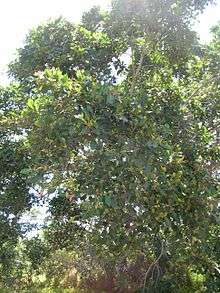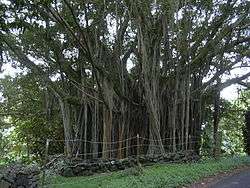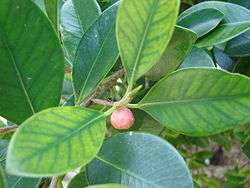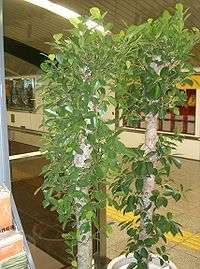Ficus microcarpa
| Ficus microcarpa | |
|---|---|
 | |
| Scientific classification | |
| Kingdom: | Plantae |
| (unranked): | Angiosperms |
| (unranked): | Eudicots |
| (unranked): | Rosids |
| Order: | Rosales |
| Family: | Moraceae |
| Genus: | Ficus |
| Species: | F. microcarpa |
| Binomial name | |
| Ficus microcarpa L.f. 1782 not Vahl 1805 | |
| Synonyms[1] | |
| |
Ficus microcarpa, also known as Chinese banyan, Malayan banyan, Taiwan banyan, Indian laurel, curtain fig, or gajumaru (ガジュマル), is a tree native in the range from China through Nepal, Bhutan, Sikkim, India, Sri Lanka, Taiwan, the Malay Archipelago, New Guinea, Australia,[2] the Ryukyu Islands,[3] and New Caledonia. It is widely planted as a shade tree[2] and frequently misidentified as F. retusa or as F. nitida (F. benjamina).[4]
Description
Ficus microcarpa is a tropical tree with smooth light-gray bark and entire oblanceolate leaves about 2-2.5 inches (5-6 cm) long which in Mediterranean climates grows to about forty feet (twelve meters) tall and with an equal spread of crown. Where conditions are favorable for the banyan habit (tropical and humid subtropical) it grows much larger, producing great numbers of prop roots. The largest known specimen is "Auntie Sarah's Banyan" at the Menehune Botanical Gardens near Nawiliwili, Kauai, Hawai'i which is 110.0 feet (33.53 meters) in height, 250 feet (76.2 meters) in crown spread, and having over one thousand aerial trunks.[5] [6] [7] [8] The F. microcarpa with the thickest trunk is also in Hawai'i, at Keaau Village, Puna District, on the Big Island. Its main trunk is 28.0 feet (8.53 meters) thick at breast height. It is also 195.0 feet (59.44 meters) in limb spread.[9] Only slightly smaller is the "Banyan at Lomteuheakal" in Vanuatu, a F. microcarpa with a main trunk 27.15 feet thick (26 meters circumference). [10]
Taxonomy


Ficus microcarpa has been described in 1782 by Carl Linnaeus the Younger. The species has a considerable number of synonyms. In 1965, E. J. H. Corner described seven varieties (and two forms of Ficus microcarpa var. microcarpa)[11] which were regarded as synonyms under the name of Ficus microcarpa in the latest Flora Malesiana volume.
Hill's weeping fig was first formally described as a species, Ficus hillii, by Frederick Manson Bailey in the Botany Bulletin of the Queensland Department of Agriculture, based on the type specimen collected in the "scrubs of tropical Queensland'".[12] In 1965, it was reassigned by E. J .H. Corner as a variety of F. microcarpa, namely F. microcarpa var. hillii.[11]
Distribution and habitat
Ficus microcarpa was widely distributed as an ornamental plant and is one of the most common street trees in warm climates. The symbiotic pollinating fig wasp, Eupristina verticillata, was introduced along with F. microcarpa. Such an introduction, however, can be delayed: in Brazil - where specimens of the tree had been used in gardening since the nineteenth century, when it was introduced by the architect Auguste François Marie Glaziou into various public parks of Rio de Janeiro - the appearance of saplings began only during the 1970s. Such saplings are considered to be very aggressive, as they can grow in the walls of buildings, bridges, highways, and other concrete structures.[13] The tree is considered a major invasive species in Hawaii, Florida, Bermuda, Central America, and South America. It's commonly used as a ornamental tree in most of Spain's mediterranean coast, as in the Balearic and the Canary islands. Ficus microcarpa can also be found on the Algarve, the southern coast of Sicily or in Cyprus. It is a common ornamental tree in the Tel Aviv, Israel area.
Ecology
The pollinating fig wasp associated with Ficus microcarpa is Eupristina verticillata. In addition, 19 non-pollinating fig wasp species parasitize Ficus microcarpa figs.[14]
These fig wasps are from different families. First, the Eurytomidae wasps are Sycophila curta, Sycophila petiolata, Sycophila maculafacies and Bruchophagus sensoriae. The wasps from the Pteromalidae family are the most speciose: Acophila microcarpae, Eufroggattisca okinavensis, Meselatus bicolor, Micranisa degastris, Odontofroggatia corneri, Odontogroggatia gajimaru, Odontogroggatia galili, Odontofroggatia ishii, Philotrypesis emeryi, Philotrypesis okinavensis, Philotrypesis taiwanensis, Sycoryctes moneres, Sycoscapter gajimaru, Walkerella kurandensis. Only one species from the Ormyridae family: Ormyrus lini.
In some parts of its introduced range, it is very attractive to avian wildlife: in São Paulo, Brazil, ten species of birds were listed as feeding on its fruits, especially Turdus rufiventris, Pitangus sulphuratus, Turdus leucomelas, Thraupis sayaca and Celeus flavescens.[15] Its fruit and leaves are also sought after and eaten by the parrot Aratinga leucophthalmus.[16] Although invasive, its hardiness makes it an important species for the attraction of avian wildlife in urban environments.[17]
Cultivation

Ficus microcarpa is cultivated as an ornamental tree for planting in gardens, parks, and in containers as an indoor plant and bonsai specimen.
References
- ↑ The Plant List: A Working List of All Plant Species, retrieved 13 April 2016
- 1 2 Zhengyi Wu; Zhe-Kun Zhou; Michael G. Gilbert, "Ficus microcarpa Linnaeus f., Suppl. Pl. 442. 1782", Flora of China online, 5
- ↑ , Yokoyama, Jun, and Kunio Iwatsuki. "A faunal survey of fig-wasps (Chalcidoidea: Hymenoptera) distributed in Japan and their associations with figs (Ficus: Moraceae)." Entomological science 1.1 (1998): 37-46.
- ↑ "Ficus microcarpa L. f.", USDA GRIN Taxonomy
- ↑ Sommer, Anthony (May 17, 1999). "Ancient Banyan Tree Returns Protector's Favor". Star Bulletin. Honolulu.
- ↑ Chang, Lester (September 14, 2003). "Auntie Sarah's Banyan". The Garden Island. Lihue.
- ↑ Sommer, Anthony (August 5, 2000). "State's Biggest Banyan Bears Heavy Fire Damage". Star Bulletin. Honolulu.
- ↑ Sommer, Anthony (March 3, 2004). "Hawaiian Cultural Icon Defended Giant Tree". Star Bulletin. Honolulu.
- ↑ Littlecott, Lorna (February 1969). "Hawai'i First". American Forests. 75 (2): 61.
- ↑ <not stated>. "Stoutest trees of the world". Retrieved April 12, 2016.
- 1 2 Corner, E. J. H. (1965). "Check-list of Ficus in Asia and Australasia with keys to identification". The Gardens' Bulletin Singapore. (digitised, online, via biodiversitylibrary.org). 21 (1): 1–186. Retrieved 5 Feb 2014. pages 22–23
- ↑ "Ficus microcarpa var. hillii (F.M.Bailey) Corner". Australian Plant Name Index (APNI), IBIS database. Centre for Plant Biodiversity Research, Australian Government.
- ↑ Carauta, Jorge Pedro Pereira & Diaz, B. Ernani, Figueiras no Brasil, Rio de Janeiro, UFRJ, 2002, ISBN 85-7108-250-2, pg.155
- ↑ Chen, Ying-Ru; Wen-Chung Chuang; Wen-Jer Wu (1999). "Chalcids wasps on Ficus microcarpa L. in Taiwan (Hymenoptera: Chalcidoidea)". Journal of Taiwan Museum. 52: 39–79.
- ↑ Somenzari, Marina; Linda Lacerda da Silva & Rosanna G. Q. Benesi (2006). "Atração de aves por Ficus elastica Roxb. e Ficus microcarpa L. em ambiente urbano (abstract)" (PDF). XIV Congresso Brasileiro de Ornitologia. Archived from the original (PDF) on 2009-02-06.
- ↑ da Silva, Linda Lacerda; Sonia Maria de Amorim Gimenez & Sumiko Namba (2006). "Método quantitativo para a avaliacão da preferência alimentar de Aratinga leucophthalmus em cativeiro (abstract)" (PDF). XIV Congresso Brasileiro de Ornitologia. Archived from the original (PDF) on 2011-07-06.
- ↑ Frisch, Johan Dalgas & Frisch, Christian Dalgas, Aves Brasileiras e Plantas que as Atraem, São Paulo:2005, ISBN 85-85015-07-1, pg.366
External links
| Wikimedia Commons has media related to Ficus microcarpa. |
- Plants of Hawaii: Ficus microcarpa, hear.org
- Ficus microcarpa L.f., Natural Resources Conservation Service of the U.S. Department of Agriculture
- Indian Laurel Invasive Plant Page, Bermuda Department of Conservation Services.